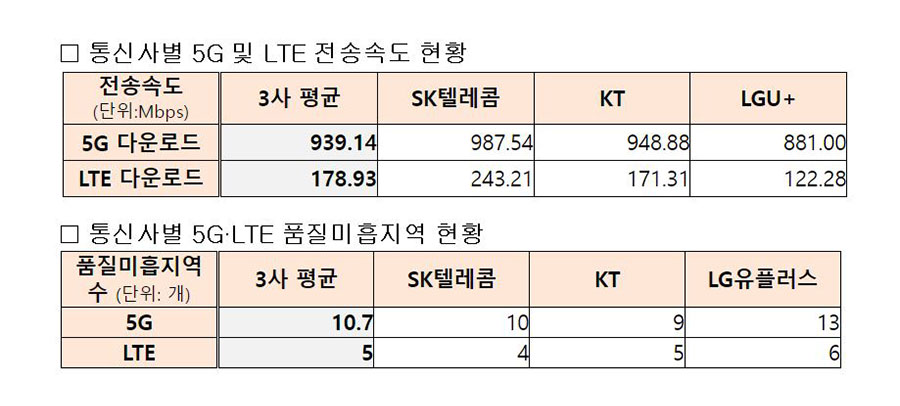이통3사의 전국 5G 통신서비스 커버리지 면적이 국토면적의 75%를 육박했다. 5G 다운로드 전송속도는 3사 평균 939.14Mbps로 작년 대비 4.8% 향상됐다. 이러한 가운데, 올해 SKT가 꾸준히 필요성을 요청해오고 있는 3.7~3.72GHz(20MHz폭) 대역의 추가할당이 이뤄질 지 귀추가 주목된다.
2023년 이통3사 5G 전송속도 전년比 4.8%↑
서울지역 1,092.62Mbps…SKT>LG유플러스>KT
SKT, 3.70~3.72GHz 대역 추가할당 요구 지속
이통3사의 전국 5G 통신서비스 커버리지 면적이 국토면적의 75%를 육박했다. 5G 다운로드 전송속도는 3사 평균 939.14Mbps로 작년 대비 4.8% 향상됐다. 이러한 가운데, 올해 SKT가 꾸준히 필요성을 요청해오고 있는 3.7~3.72GHz(20MHz폭) 대역의 추가할당이 이뤄질 지 귀추가 주목된다.
과학기술정보통신부와 한국지능정보사회진흥원(NIA)는 지난 27일 2023년 통신서비스 커버리지 점검 및 품질평가 결과를 발표했다. 이번 품질평가는 삼성전자 갤럭시 S22 울트라 단말을 이용해 △무선인터넷(5G, LTE, 3G, WiFi) △ 유선인터넷(100Mbps급, 500Mbps급, 1Gbps급, 10Gbps급) 등을 대상으로 진행됐다.
2023년 10월 기준 커버리지 면적은 3사 평균 75,763.59㎢로, 국토면적의 75.25%에 달했다. 이통3사는 전국 지하철 역사 및 노선, 고속철도 역사 및 노선, 고속도로 노선에 대해 5G를 구축했다.
전국 200개 법정동에서 3사 평균 2.7개(SKT 2개, KT 2개, LG유플러스 4개) 법정동에서 5G 커버리지를 과대 표시한 것이 밝혀졌지만, 180개 주요 시설에서 단말이 안정적으로 5G 망에 접속가능한 비율은 이통 3사 평균 96.62%에 달하는 것으로 나타났다. 해당 수치가 낮을수록 주요 시설 내 5G 전파 신호세기가 약하다.
 ▲2023년도 통신서비스 품질평가 결과(과기부 자료)
▲2023년도 통신서비스 품질평가 결과(과기부 자료)
5G 서비스 품질평가 결과, 5G 다운로드 전송속도는 3사 평균 939.14Mbps로, 전년 대비 4.8% 향상됐다. 통신사별 속도는 SKT 987.54Mbps, KT 948.88Mbps, LGU+ 881.00Mbps이다. 특히 밀집지역, 실내시설, 교통시설 등 주요 시설에서는 961.24Mbps로 전년 대비 6.6% 향상됐다.
주요 교통 시설에서 지하철이 고속도로, 고속철도보다 속도가 빨랐고, 대도시가 중소도시, 농어촌보다 빨랐다. 특히 서울 지역은 3사 평균 1,092.62Mbps로, 전년 대비 15.7% 향상됐다. SKT 1,101.37Mbps, LG유플러스 1,099.79Mbps, KT 1,076.71Mbps 순이다. LG유플러스는 5G 주파수 추가할당의 영향으로 5G 속도가 전년 대비 21.9% 향상됐다.
전체 400개 점검지역 중 전송속도가 12Mbps 이하인 5G 서비스 품질 미흡 지역은 3사 평균 10.7개다. SKT 10개, KT 9개, LG유플러스 13개다.
한편 LTE 서비스의 3사 평균 다운로드 속도는 178.93Mbps로 전년 대비 17.8% 향상됐다. SKT(243.21Mbps), LG유플러스(122.28Mbps), KT(171.31Mbps) 순이다.
■ SKT, 3.7~4.72GHz 대역 추가할당 받나
옴디아는 2023년 말 기준 5G가 전 세계 18억개 연결을 달성했다고 예측한 만큼 5G는 양적, 질적으로 성숙한 단계로 접어들었다. 과기부에 따르면 2023년 10월 기준 국내 무선 통신서비스 5G 전체 가입자 수는 약 3,216만명으로, 2022년 약 2,698만명보다 500만명 이상이 증가했다.
5G 주파수 대역은 Sub-6GHz와 mmWave(28GHz)가 존재하며, 이론상 최대 속도는 하향(다운로드) 최대 20Gbps, 상향 최대 10Gbps 수준이다. 이는 4G의 10배에 달하는 속도지만 mmWave 고주파수 대역에 해당하며, 현재 우리나라 전국 커버리지에 해당하는 5G는 3.5GHz 대역에 인접해 있다.
SKT는 현재 3.60GHz~3.70GHz, KT는 3.50GHz~3.60GHz, LG유플러스는 3.40GHz~3.50GHz 대역으로 LG유플러스는 작년에 추가 20MHz폭을 할당 받은 상태다. 이러한 가운데 SKT는 2022년부터 꾸준히 3.70GHz~3.72Ghz(20MHz폭) 대역의 추가 할당을 요청해오고 있다.
한편 SKT가 5G 가입자 수가 가장 많은 데 비해 할당 받은 주파수 대역폭이 동일해 가입자당 활용 가능 주파수가 낮은 것으로 나타났다. 실제로 LG유플러스는 추가 20MHz폭을 추가 할당 받은 뒤, 총 100MHz폭의 주파수를 이용하게 되면서 품질이 크게 향상되기도 했다.
따라서 만약 SKT가 추가로 20MHz 대역폭을 할당 받게 되면 SKT는 가입자 수를 유지하면서도 품질을 향상할 수 있을 것으로 기대된다. 그러나 KT와 LG유플러스 입장에서는 오히려 경쟁에 격차가 벌어지게 되는 셈이기 때문에 쉽게 허용하기 어려울 수밖에 없다.
과기부는 통신시장 경쟁촉진 방안과 통신비 부담 완화 방안의 일환으로 이용자에게 합리적인 LTE/5G 요금을 책정함에 있어 5G 전국 커버리지 뿐만 아니라 전송속도를 고려해야 한다. 또한 사업자별 차별적인 주파수 할당이 통신시장 경쟁 구조에 미치는 영향에 주안점을 두고 실질적인 대책을 마련해야 한다.
과기부 김경만 통신정책관은 “5G 품질 평가에 따라 각 통신사에게 품질 개선을 요청하고, 개선 여부를 재점검함과 동시에 대도시와 농어촌의 품질 격차도 점차 줄여 나가도록 통신사에 개선을 촉구할 것”이라고 전했다.